 |
 |
 |
| |
Kinetics of Platelet Counts following Interruption of ART: Results from the SMART Study (coagulation pathways, HIV replication itself or inflammation)
|
| |
| |
Reported by Jules Levin
CROI 2011 March 2 Boston
1E Zetterberg, 2J Neuhaus, 2,3JV Baker, 4C Somboonwit, 5JM Llibre, 6A Palfreeman, 7M Chini, 1JD Lundgren for the INSIGHT SMART Study Group
1University of Copenhagen, Copenhagen, Denmark; 2University of Minnesota, Minneapolis, MN USA; 3Hennepin County Medical Center, Minneapolis, MN, USA;
4Hillsborough County Health Department, Tampa, FL, USA; 5Hospital Universitari Germans Trias I Pujol, Barcelona, Spain;
6Medical Reasearch Council Clinical Trials Unit, London, UK; 7Red Cross General Hospital, Athens, Greece
STUDY OBJECTIVE:
In this study we investigated the effect of interruption of ART and the corresponding increase in HIV viral load on platelet kinetics.
AUTHOR SUMMARY
The incidence of developing significant thrombocytopenia (<100,000/mL) was higher in the DC group vs. VS group.
Thrombocytopenia developed rapidly (within the first 4 months) after discontinuing ART in the DC group and was not correlated with changes in hemoglobin levels, suggesting that platelet changes are more likely due to consumption than a decrease in production.
Changes in HIV-RNA levels were inversely correlated with changes in platelet count in DC patients with initially suppressed viral loads, suggesting an association between thrombocytopenia and HIV replication.
In patients interrupting ART, increases in D-dimer levels were correlated with decreases in platelet counts, suggesting an association between thrombocytopenia and activation of coagulation.
AUTHOR CONCLUSIONS
Interruption of ART causes thrombocytopenia in <10% of patients. Re-initiation of ART reverses the thrombocytopenia. Factors contributing to declines in platelets after interrupting ART may, in part, include activation of coagulation pathways, HIV replication itself or inflammation more broadly. The contribution of platelets in HIV-related pro-coagulant activity requires further study.
BACKGROUND
· In the SMART study, HIV infected patients were randomly assigned to either continuous (viral suppression, VS arm) or CD4 guided episodic use of antiretroviral therapy (ART)(drug conservation, DC arm).
· There was in increased risk of all-cause mortality in the DC arm. Causes of death were mainly major cardiovascular, renal and hepatic disease and not opportunistic disease as might be expected1.
· Mortality risk in SMART during follow-up was associated with higher baseline levels of hsCRP, IL-6, and D-dimer2 suggesting involvement of both the inflammatory and coagulation systems.
· In SMART, D-dimer levels were correlated with HIV viral load at study entry, and changes in D-dimer levels were correlated with changes in HIV viral load both after starting or stopping ART2,3.
· These data suggest that HIV replication may result in activation of coagulation pathways.
Coagulation - Wikipedia, the free encyclopedia
The coagulation cascade of secondary hemostasis has two pathways which lead to fibrin formation. These are the contact activation pathway (also known as the ...en.wikipedia.org/wiki/Coagulation
Coagulation is a complex process by which blood forms clots. It is an important part of hemostasis (the cessation of blood loss from a damaged vessel), wherein a damaged blood vessel wall is covered by a platelet and fibrin-containing clot to stop bleeding and begin repair of the damaged vessel. Disorders of coagulation can lead to an increased risk of bleeding (hemorrhage) or obstructive clotting (thrombosis).
Coagulation is highly conserved throughout biology; in all mammals, coagulation involves both a cellular (platelet) and a protein (coagulation factor) component. The system in humans has been the most extensively researched and is therefore the best understood.
Coagulation begins almost instantly after an injury to the blood vessel has damaged the endothelium (lining of the vessel). Exposure of the blood to proteins such as tissue factor initiates changes to blood platelets and the plasma protein fibrinogen, a clotting factor. Platelets immediately form a plug at the site of injury; this is called primary hemostasis. Secondary hemostasis occurs simultaneously: Proteins in the blood plasma, called coagulation factors or clotting factors, respond in a complex cascade to form fibrin strands, which strengthen the platelet plug.
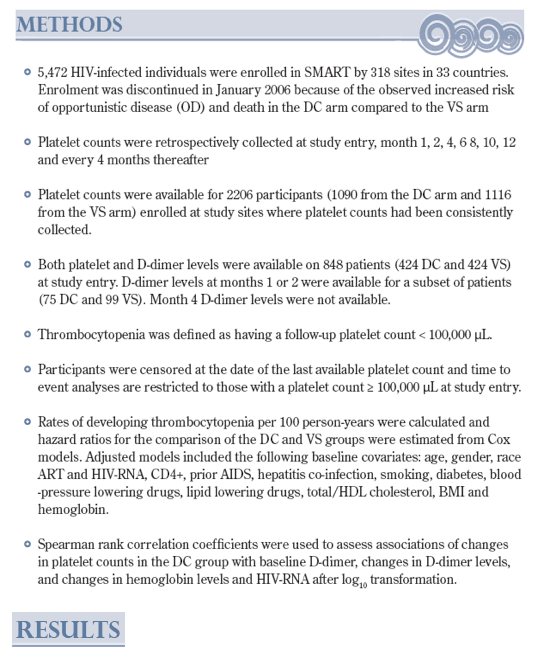
The median (IQR) platelet count was 236,000/μL (199,000-281,000) at study entry (Table 1).
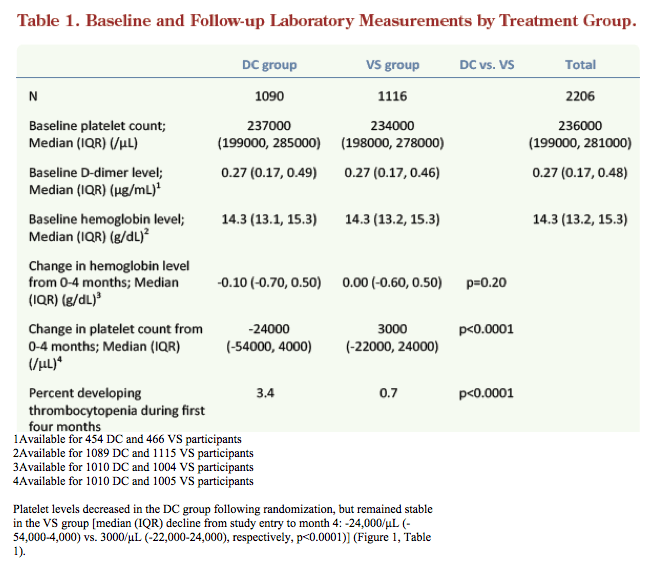
1Available for 454 DC and 466 VS participants
2Available for 1089 DC and 1115 VS participants
3Available for 1010 DC and 1004 VS participants
4Available for 1010 DC and 1005 VS participants
Platelet levels decreased in the DC group following randomization, but remained stable in the VS group [median (IQR) decline from study entry to month 4: -24,000/μL (-54,000-4,000) vs. 3000/μL (-22,000-24,000), respectively, p<0.0001)] (Figure 1, Table 1).
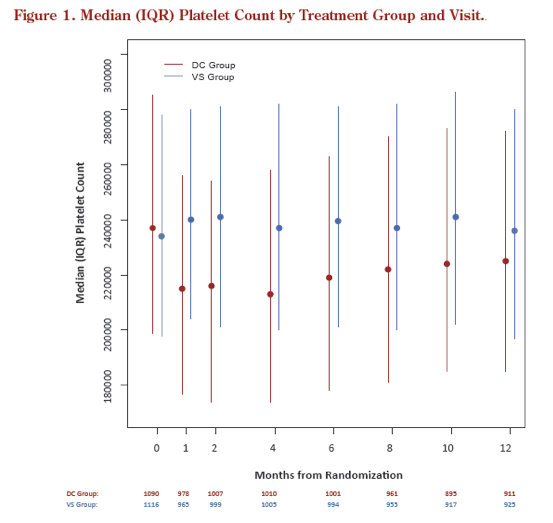
The rate of developing thrombocytopenia (<100,000/μL) was significantly higher in the DC arm vs. VS arm (unadjusted DC/VS HR (95%CI) = 1.8 (1.2-2.7)) (Table 2). The higher risk of developing thrombocytopenia in the DC vs. VS group was evident during
the first 4 months [adjusted hazard ratio (aHR) DC/VS=9.0 (95% CI: 2.7-29.6)], but not thereafter (number of incident thromboytopenia events after 4 months was 33 DC and 33 VS [aHR=1.1 (0.7-1.8); interaction DC/VS vs. time: p=0.0006].
Hepatitis co-infection was the only baseline covariate associated with developing thrombocytopenia within the first four months (aHR (95%CI) = 2.3 (1.0-5.1) p=0.05).
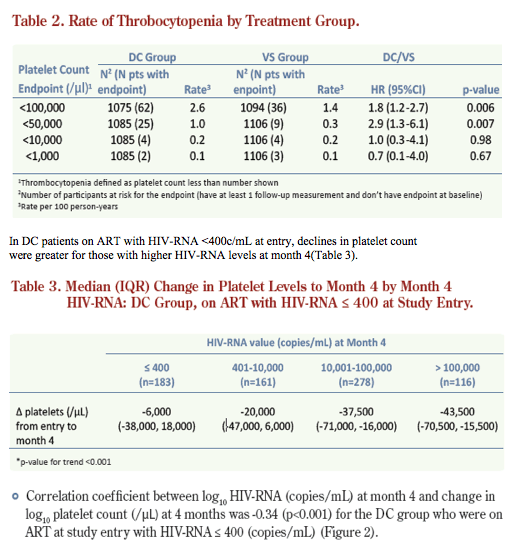
In DC patients on ART with HIV-RNA <400c/mL at entry, declines in platelet count
were greater for those with higher HIV-RNA levels at month 4(Table 3).
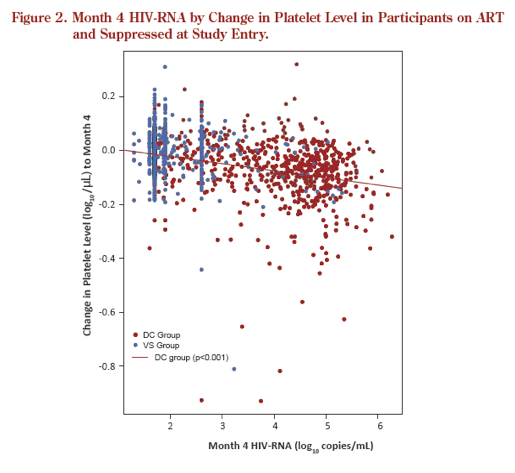
The early decrease in platelet numbers was not associated with levels of D-dimer at study entry, nor with change in the hemoglobin levels [correlation= 0.02 (p=0.66) and -0.06 (p=0.06), respectively.
However, for DC patients with D-dimer values available at baseline and either month 1 or month 2 (n=75), the correlation coefficient between change in D-dimer and change in platelets was -0.24 (p=0.04). The association was even stronger [r=-0.41 (p=0.02)] for DC patients who were on ART and had a suppressed VL at study entry (n=33). For those off ART at study entry this correlation coefficent was 0.17 (p=0.39) (fig 3).
Median (IQR) D-dimer levels at study entry for those in Figure 3 were 0.29 (0.16, 0.56) ug/mL for those on ART and 0.74 (0.34, 1.06) ug/mL for those off ART. Corresponding median (IQR) study entry platelet levels were 236,000 (198,000, 275,000) /uL for those on ART and 224,000 (205.00, 277.00) / uL for those off ART.
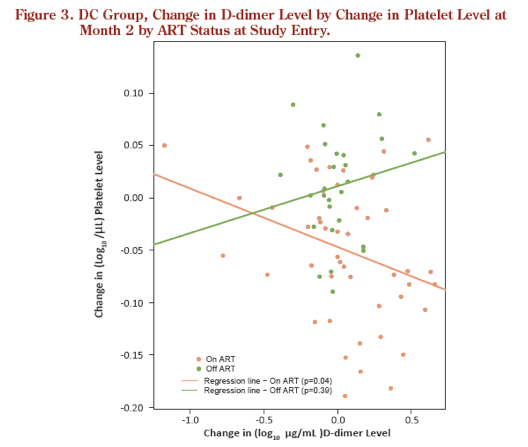
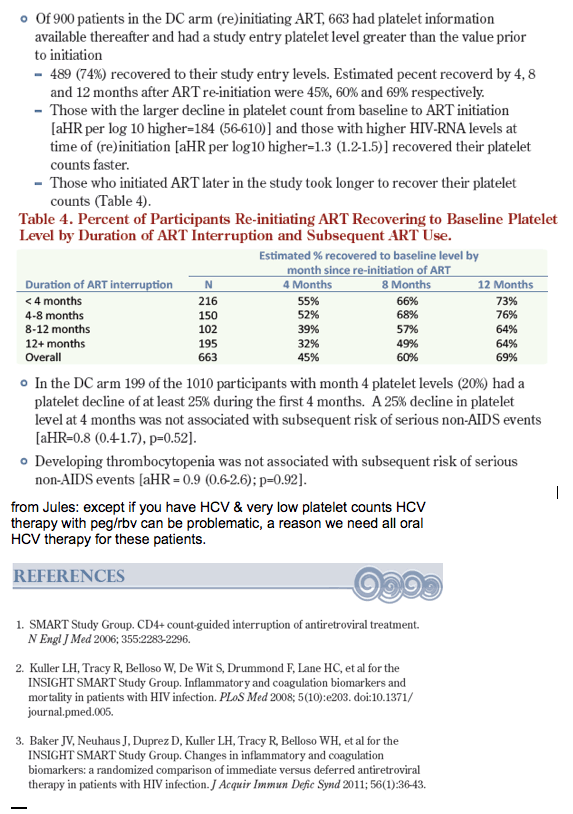
|
| |
|
 |
 |
|
|